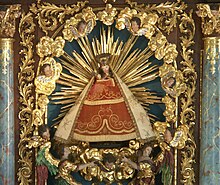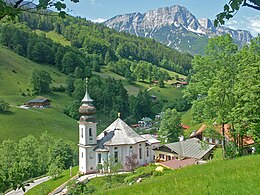Maria Gern (Berchtesgaden)
|
Maria gladly
Berchtesgaden market
|
|
|---|---|
| Coordinates: 47 ° 39 ′ 20 ″ N , 13 ° 0 ′ 9 ″ E | |
| Height : | 740 (730-990) m |
| Area : | 5.45 km² |
| Residents : | 438 (May 25, 1987) [1] |
| Population density : | 80 inhabitants / km² |
| Incorporation : | January 1, 1972 |
| Postal code : | 83471 |
| Area code : | 08652 |
Maria Gern (until June 3, 1953: Gern ) is a district of the Berchtesgaden market in the Upper Bavarian district of Berchtesgadener Land and was an independent municipality until December 31, 1971.
Location and structure
Maria Gern is located north of the center of Berchtesgaden in the valley and on the slopes of the Gerner Bach (also Gererbach or Anzenbach), a tributary of the Berchtesgadener Ache . The area is bounded in the west by the Rauhenkopf , an extension of the Untersberg massif , in the east by the Kneifelspitze and in the north by the Almbachklamm . The wide valley floor, which narrows towards the south, ends in a gorge .
The municipality of Maria Gern, which was independent before 1972, comprised the Gnotschaftsbezirke Vordergern (largest district with the parish seat and pilgrimage church Maria Gern ), Obergern and Hintergern as well as the settlement and the former hamlet Am Etzerschlößl , and from 1817 to 1818 also the Gnotschaftsbezirke Anzenbach and Metzenleiten , the ones after that also since 1972 no longer independent municipality or the current Berchtesgadener district Salzberg were attached.
history
Original message from the monastery of Berchtesgaden
In the course of the Landbrief issued by Provost Ulrich Wulp in 1377 , Gern with three "Gnotschaftsbezirken", the current districts of Hintergern, Obergern and Vordergern, probably became one of the eight "Ur gaden " of the Berchtesgadener Land as early as the end of the 14th century . From 1155 onwards, the area of the Berchtesgadener Land corresponded to the heartland of the Berchtesgaden monastery , which in 1380 had been elevated to the status of the Imperial Prelature of Berchtesgaden and in 1559 to the imperial provost of Berchtesgaden . Gern was first mentioned in writing as a Gnotschaft in the first tax book of the Berchtesgadener Land from 1456.
In the 16th century, local salt and wood traders spread Reformation thoughts and writings that they obtained on their travels to the Protestant cities of Augsburg , Nuremberg and Regensburg . An important nucleus of Protestantism was formed by Dürrnberg, which is neighboring in Salzburg . Along with Au , Scheffau and Schellenberg, he was one of the first Gnotships in the Berchtesgadener Land, in which this Christian denomination had found its followers. But on April 22nd, 1733 the Protestants were expelled from the prince provostie of Berchtesgaden. 800 Auer, Scheffauer and “Gerer” had to set out by ship via Hallein to Regensburg and from there to walk to the cities and communities of Kurhannover .
Secularization, connection to Bavaria
In 1803 the prince provostie Berchtesgaden was dissolved and the Berchtesgadener Land lost its political independence. After three changes of rulership in quick succession, its territory and its localities were annexed to the Kingdom of Bavaria in 1810, and the Gnotschaft became the community of Gern, while its former Gnotschaft districts or districts Hintergern , Obergern and Vordergern are still called "Gnotschaften" today.
Next to the pilgrimage church Maria Gern , the inn and school were the cultural and social center of the community. Around 1800 the inn was also a sacristan's house, beer tavern and schoolhouse. In this so-called Winkelschule , the sacristan himself usually gave the lessons . In 1803, however, this connection between pub and school was met with criticism: “Up until now, the classroom was also a drinking room for the notables of Berchtesgaden; the children camped around the same tables to study and the adults to drink. This remains indecent even if the sexton's apology that the adults only come after school should be true ... "
On August 17, 1804, the sacristan Josef Stanger was appointed as the previous school owner as a "public school teacher" and converted his Winkelschule Gern into a free public weekly school. The classroom in a building of the Roman Catholic Church, however, was still at the same time a drinking room for the dignitaries with the teacher Stanger as their host.
After a resolution was passed in June 1854, a school building was built next to the church in 1869/70, which in 1926 offered space for around 64 children and which also housed the parish office.
time of the nationalsocialism
The district office responsible for the place Berchtesgaden was renamed in 1939 in the district of Berchtesgaden with the same area of responsibility.
post war period
The municipality name Gern was only changed to "Municipality Maria Gern" in 1953 by a ministerial decision.
100 years after it was established, the Gerner Schule was closed on July 23, 1969, and the schoolchildren have been taking the school bus to Berchtesgaden school since then.
In the course of the regional reform in Bavaria , the municipality lost its independence on January 1, 1972 and has since been a district of the Berchtesgaden market and the newly formed district of Berchtesgadener Land .
When the unincorporated area of Bischofswiesener Forst in the north-west was dissolved on January 1, 2010 , part of this area was added to the Maria Gern district.
coat of arms
| Blazon : “In blue the growing, golden (yellow) crowned St. Mary with a silver (white) veil and undergarment and red cloak, on her right arm holding the golden (yellow) crowned and blue-clad baby Jesus. " | |
| Justification of the coat of arms: The coat of arms designed by Otto Hupp shows St. Mary with the baby Jesus , patron saint and namesake of the community. The coat of arms is therefore also speaking for the place name. |
Local politics
Until the formation of the community of Gern, the Gnotships elected a “Gnotschafter” from their ranks every two years. This had a variety of tasks. This included, for example, the collection of taxes and the forwarding of official government orders. He was also present when discussing road and bridge construction measures, stream regulations and the like. As a poor carer he was responsible for the selection and support of the needy people.
With the formation of the communities according to the second community edict in Bavaria of 1818, the administration of the community went to the community committee headed by the community leader. The community leaders and mayors (from 1945) of the community of Gern after 1818 were:
- 1818–1824 Anton Kurz
- 1824–1830 Franz Renoth
- 1830–1834 Georg Renoth
- 1834–1839 Franz Renoth
- 1839–1845 Georg Walser
- 1845–1856 Georg Renoth
- 1856–1869 Michael Renoth
- 1869–1873 Georg Springl
- 1873–1881 Georg Renoth
- 1881–1883 Johann Plenk (bishop's fief)
- 1883–1893 Michael Holz (Schwaigerlehen)
- 1893–1906 Georg Renoth (Fendtleitlehen)
- 1906–1909 Michael Stanger (front right)
- 1909–1912 Josef Walch (Braunlehen)
- 1912–1919 Sebastian Hasenknopf (Unterlapflehen)
- 1919–1924 Franz Rasp (Hartlerlehen)
- 1924–1934 Heinrich Maußner (Fendtleitbichl)
- 1934–1935 Josef Rieder (Theresienklause)
- 1935–1945 Franz Datz (Saghäusl)
- 1945–1946 Franz Springl (Fluchthäusl)
- 1946–1956 Franz Seidinger (Schönbichl)
- 1956–1971 Josef Fegg (fief)
Culture and sights

Cultural traditions
Within Berchtesgaden and among each other, the residents of Maria Gern have always been colloquially referred to as Gerer rather than "Gerner" .
For the Buttnmandllauf ( Bavarian : buttn = rattle, shake), which has been practiced in the former Berchtesgadener Land since around 1730 as a stopover during the Advent season, mostly on 5th / 6th December ( St. Nicholas ), Maria Gern uses one of the three holy Rauhnächte , namely December 24th, in a different way than since the Middle Ages .
The two figures of the miraculous image in the pilgrimage church of Maria Gern , Madonna and Child, are dressed in splendid baroque robes in the appropriate colors to match the period of the church year.
The Maria Gern brass band was founded in 1946 by Johann Rasp, but an earlier Gerer Musi was mentioned shortly after the First World War .
Like most places in the Berchtesgadener Land, Maria Gern also owns an association of Christmas shooters . This celebrated its 100th anniversary in 2007.
Buildings
The best-known building and “landmark” of this district is the Maria Gern pilgrimage church, built around 1669 and 1724 , which since 1773 has had its own sacristan . In it, above the high altar, is the miraculous image of a Madonna and Child from 1666, carved by a Gerer , which, in a simplified stylization, also became a characteristic part of the municipal coat of arms. Also noteworthy are the numerous votive tablets with which the believers thanked for their prayers.
literature
- Manfred Feulner : Berchtesgaden - history of the country and its inhabitants. Berchtesgadener Anzeiger publishing house, Berchtesgaden 1985, ISBN 3-925647-00-7 .
- Hellmut Schöner (Ed.), A. Helm : Berchtesgaden in the course of time. Reprint from 1929. Association for local history d. Berchtesgadener Landes. Berchtesgadener Anzeiger and Karl M. Lipp Verlag, Munich 1973.
- Hellmut Schöner (Ed.): Berchtesgaden through the ages - supplementary volume I. Association for local history d. Berchtesgadener Landes. Verlag Berchtesgadener Anzeiger and Karl M. Lipp Verlag, Munich 1982 ISBN 3-87490-528-4 .
Web links
Individual evidence
- ↑ Bavarian State Statistical Office (Hrsg.): Historical municipality register: The population of the municipalities of Bavaria in the period from 1840 to 1952 (= contributions to Statistics Bavaria . Issue 192). Munich 1954, DNB 451478568 , p. 249 , urn : nbn: de: bvb: 12-bsb00066439-3 ( digitized version ).
- ↑ a b c d e f g h i j Manfred Feulner: Maria Gern - Gnotschaft and community on behalf of the Maria Gern brass band . Literature and sources: berchtesgadeninfo.de, Market Archive Berchtesgaden, Dept. Maria Gern.
- ↑ Joseph Ernst von Koch-Sternfeld: History of the Principality of Berchtesgaden and its salt works . Volume 2, from p. 27 f.
- ↑ Dieter Albrecht : Fürstpropstei Berchtesgaden - Statistical overview based on the status of 1698. I. District and Nursing Court Berchtesgaden. Chapter: Gnotschaft Gern In: Historical Atlas of Bavaria . Part Altbayern, Heft 7, Munich 1954, p. 25 u.
- ↑ a b c berchtesgaden-evangelisch.de Alfred Spiegel-Schmidt: Reformation and emigration in the Berchtesgadener Land. Text on the emigration of Protestants from the prince-provost of Berchtesgaden.
- ↑ The residents of Gern , Maria Gern since 1953 , were and are called "Gerer" in the local dialect ( see also section: Cultural traditions ).
- ↑ Joseph Ernst von Koch-Sternfeld: History of the Principality of Berchtesgaden and its salt works . Volume 3, from pp. 68–69
- ↑ Joseph Ernst von Koch-Sternfeld: History of the Principality of Berchtesgaden and its salt works . Volume 2, from p. 145 f.
- ↑ a b c Hellmut Schöner: Berchtesgaden through the ages. Supplementary Volume I, 1982, p. 99
- ^ Wilhelm Volkert (ed.): Handbook of Bavarian offices, communities and courts 1799–1980 . CH Beck, Munich 1983, ISBN 3-406-09669-7 , p. 434 .
- ↑ Unser Bayern , local supplement of the Bayerische Staatszeitung , 1964, p. 40; see Berchtesgaden: Maria Gern , online at kommunalflaggen.eu .
- ↑ Hellmut Schöner: Berchtesgaden through the ages . Supplementary Volume I, 1982, p. 207
- ↑ Hellmut Schöner: Berchtesgaden through the ages. Supplementary Volume I, 1982, pp. 345-352.
- ^ FR: All of Maria Gern was on her feet in the Berchtesgadener Anzeiger on September 12, 2007




